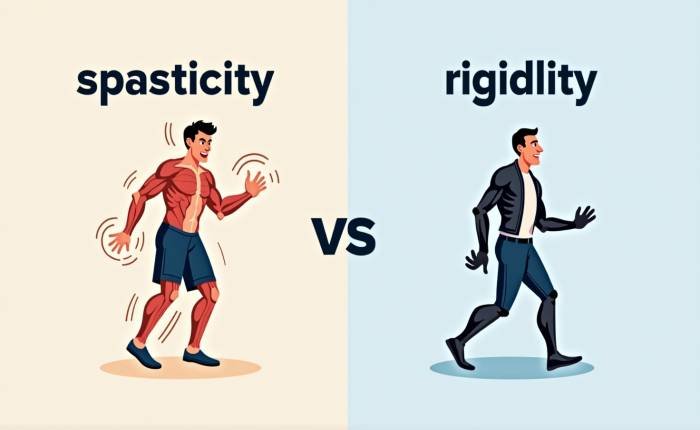Muscle Tone Disorders Demystified: Spasticity vs Rigidity

What’s the Difference Between Spasticity and Rigidity?
Ever feel your muscles get tight or jerk? I’m a physical therapist, and I’ll explain spasticity vs rigidity simply. These conditions affect how muscles move because of brain or nerve issues.
Spasticity causes tight muscles that twitch, like my patient Sarah’s leg jerking after her stroke. Rigidity keeps muscles stiff, slowing you down. Check this table:
| Feature | Spasticity | Rigidity |
| What It Is | Tight muscles with spasms | Always stiff muscles |
| How It Moves | Jerky, sudden moves | Slow, stiff moves |
| Main Cause | Stroke, cerebral palsy, MS | Parkinson’s disease |
Knowing spasticity vs rigidity helps you spot issues and get help. I’ve seen the right care change lives. Let’s look at what they are, why they happen, and how to fix them.
What Is Spasticity and How Does It Feel?
Wonder why muscles won’t relax? Spasticity makes muscles tight and jumpy, often from nerve damage, like in stroke or MS. It can make walking hard.
It feels like a tight spring snapping. My client John said his arm “fights back” when stretching. Spasticity vs rigidity starts with feeling these signs, and I’ve seen therapy help a lot.
What Is Rigidity and Why Does It Happen?
Feel like your muscles are stuck? Often caused by Parkinson’s disease, rigidity slows you down by keeping your muscles stiff all the time. It’s not jumpy like spasticity.
It’s like moving a rusty gear. It was difficult for my uncle with Parkinson’s to button his shirt. Here’s a comparison:
| Aspect | Spasticity | Rigidity |
| Muscle Feel | Tight with spasms | Always tight |
| Movement | Jerky, unpredictable | Slow, careful |
| Brain Issue | Nerve damage | Brain movement control |
Understanding spasticity vs rigidity helps find the right treatment. I’ve seen medicine and therapy work well. A doctor can guide you.
What Causes Spasticity?
Why do muscles act up? Damage to the brain or spinal cord can disrupt nerve signals, resulting in spasticity. Stroke, cerebral palsy, or injuries cause it, says the NIH.
This damage makes muscles tight and jumpy. Tiredness or sickness can make it worse. Knowing spasticity vs rigidity causes helps you get help fast.
What Causes Rigidity?
Why are muscles always stiff? According to the Parkinson’s Foundation, rigidity results from Parkinson’s disease, in which brain cells responsible for movement malfunction. It slows you down.
The brain can’t control muscle tightness. Unlike spasticity vs rigidity, it’s steady, not twitchy. Stress or cold makes it worse, like with my uncle.
How Do Spasticity and Rigidity Affect Life?
How do these change your day? Spasticity makes walking hard with sudden jerks. Rigidity slows tasks like eating, as my patients tell me.
Both tire you out and hurt. Knowing spasticity vs rigidity effects helps find fixes. Therapy or tools, which I suggest, make life easier.
What Are Spasticity Symptoms?
What does spasticity look like? You get tight muscles, sudden jerks, and trouble moving, often in arms or legs. Quick moves trigger it, I’ve seen in therapy.
It can stiffen joints over time. It’s linked to MS. Spotting spasticity vs rigidity signs early gets you help.
What Are Rigidity Symptoms?
How does rigidity feel? It’s constant muscle stiffness, slowing moves like a stuck hinge, often from Parkinson’s. Patients struggle with turning, I’ve noticed.
Unlike spasticity vs rigidity, it’s not jerky, just stiff. It can mess with posture. Noticing symptoms early, as I tell clients, helps manage it.
How Are Spasticity and Rigidity Diagnosed?

How do doctors figure it out? They check muscle tightness, reflexes, and moves, as I do with patients and neurologists. Your health history matters.
Spasticity shows jumpy reflexes, rigidity feels stiff. MRIs find causes, experts say, for better spasticity vs rigidity treatment.
What Treatments Help Spasticity?
What calms jumpy muscles? Therapy, medicines like tizanidine, or Botox help, per Neurology studies. I teach patients stretches to ease tightness.
Severe cases may need a baclofen pump. Treatments for spasticity versus rigidity concentrate on spasms. A doctor’s advice is key, I’ve learned.
What Treatments Work for Rigidity?
How do you fix stiff muscles? Levodopa helps movement, says the Parkinson’s Foundation. Therapy keeps muscles loose, which I’ve seen work well.
Unlike spasticity vs rigidity, rigidity treatments ease constant tightness. Deep brain stimulation helps tough cases. A neurologist, I’ve worked with, plans best.
Can Lifestyle Changes Help?
Can simple changes help? As I’ve observed with clients, relaxation, stress reduction, and exercise do indeed reduce spasticity as opposed to rigidity. Stretches or yoga are beneficial.
Eating healthy and drinking water stop cramps. A therapist, as I suggest, makes routines fit you for spasticity vs rigidity.
Conclusion
Hey, knowing spasticity vs rigidity helps you take charge. Spasticity causes jerky spasms; rigidity slows with stiffness, needing different care. I’ve seen therapy and lifestyle changes improve lives.
FAQs
What is the difference between spasticity vs rigidity?
Spasticity is muscle tightness that changes with movement, while rigidity is constant stiffness, no matter how you move.
Can spasticity vs rigidity affect walking?
Yes, both can cause trouble walking. Spasticity may make steps uneven, while rigidity may make movement feel stiff and slow.
Is spasticity vs rigidity caused by brain problems?
Yes, both often happen after brain or spinal cord injury. They are signs the nervous system isn’t working right.
How is spasticity vs rigidity treated?
Doctors use therapy, medicine, and sometimes surgery. Treatments are picked based on how each affects your daily life.
Are spasticity vs rigidity common in stroke patients?
Yes, stroke often causes spasticity. Rigidity is less common but can happen, especially in brain injuries like Parkinson’s.




